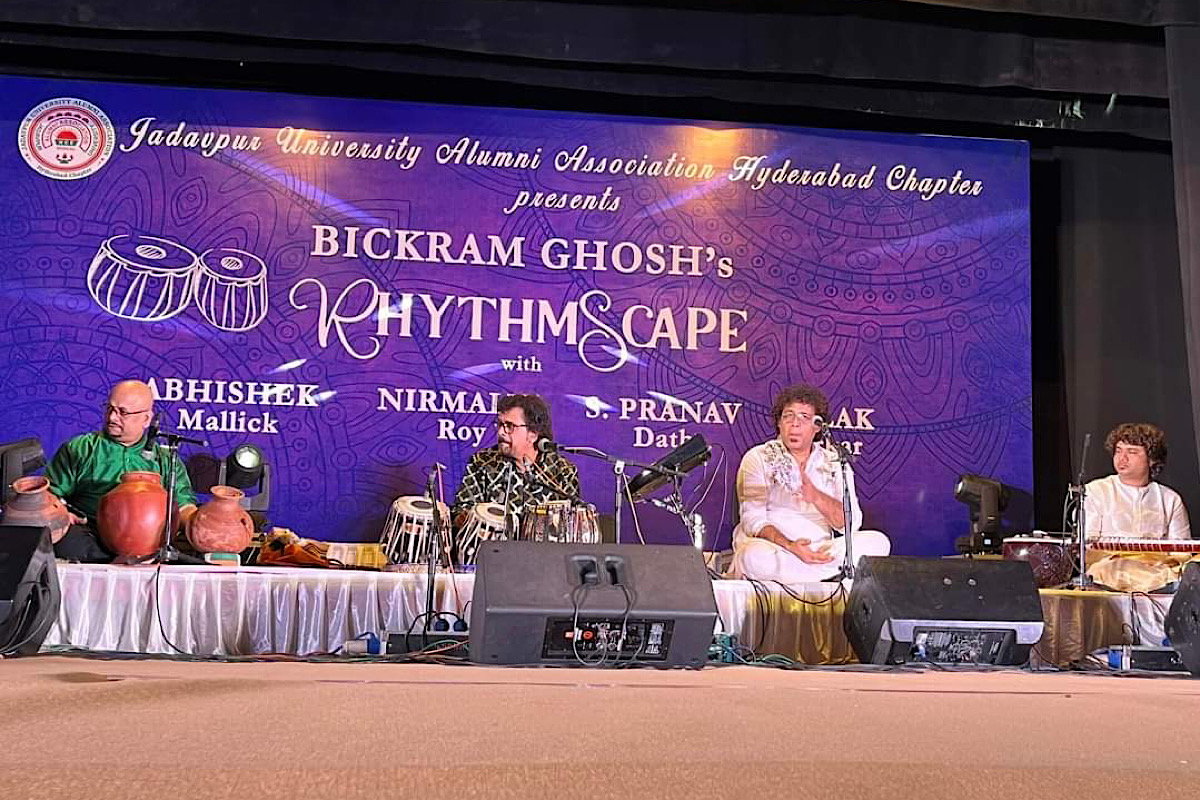On a hot, sultry evening, in the midst of an intense heat wave, the clap of thunder and rumble of clouds, signalling impending rain, greeted the audience at the Ravindra Bharathi auditorium in Hyderabad. However, they were drenched not by rain but by the mesmerising music created by tabla maestro Bickram Ghosh and his fusion band Rhythmscape. Ghosh was accompanied by a stellar ensemble of musicians: V Suresh on ghatam, S Pranav Dath on drums, Abhisekh Mallick on sitar, Pulak Sarkar on keyboard, and Nirmalya Roy performing the vocals. The musical evening was organised by the Jadavpur University Alumni Association, Hyderabad Chapter, to raise funds for its philanthropic activities.
Ghosh, who easily segues between the world of poor classical music and the genre of fusion music, formed his iconic band Rhythmscape about 22 years ago. But as he pointed out to the audience at the very beginning, no two shows were alike since a lot of it was pure improvisation on the part of the musicians. The first composition they chose for the evening was the Dance of Shiva (tandav), based on Raag Jog. And the edgy, energetic piece was the perfect opening for the concert, setting the very mood of the evening. The next composition, “Zinc”, was based on the musical experiences of listening to jazz performances at New York’s Zinc Bar. Jazz subtly ran through the entire composition, which was based on Raag Megh, before moving on to Raag Malhar, producing an enchanting blend of musical genres. The audience was transported to a monsoon day complete with the ominous gathering of stormy clouds, the clap of thunder, and the pitter-patter of raindrops.
The next one was also a “cocktail” as Ghosh described it, but of North and South Indian classical music. Since he had trained in Carnatic music and accompanied several renowned musicians, such as M. Balamuralikrishna, he incorporated certain Carnatic influences into his music. The raag chosen was Charukeshi, followed by tani avartam, or drum jamming, between Suresh, Pranav and Ghosh, with each of them displaying their technical and creative prowess and adaptability. Suresh was a treat to watch, and Ghosh, of course, went beyond his percussion instruments and tapped his cheeks to produce unique sounds. He thumped his chest to perfectly replicate the throbbing beat of the heart. Before the concert, Ghosh shared, “I do a lot of stuff, which is simply crazy. I play my chest and my body, and I throw the tabla into the air. I was heavily criticised in the early days, and now, after so many days, when people say it is iconic, it is ironic for me.” The audience got a glimpse of that iconic percussion wizard during the high-octane drum jam.
The trio then carried on a conversation between them in their unique “drumming” language, much to the delight of the audience. “Pranav is from Bangalore. What is the traffic in Bangalore like?” asked Ghosh. Pranav’s reply in rapid beats perfectly captured the hustle and bustle of the city’s chaotic traffic. While Pranav sat with his full set of drums and unleashed a storm of beats, Ghosh gave a pitiful look at the three clay pots and wondered aloud if Suresh could at all match up to that. The ghatam maestro had put on an equally sorry face, pointing at his own bald head and Pranav’s thick curls before raising a storm of his own on the ghatam.
The penultimate piece Ghosh chose for the evening was a composition created by the sitar maestro Pandit Ravi Shankar while raising funds for Bangladesh in 1971. Although a great number of global artists, like George Harrison, participated in the concert, the mellifluous essence of the piece was truly Bengali. Fifty years later too, it struck a chord among the large section of probashi Bengalis in the audience. Sitarist Abhisek Mallick took the lead, but the goosebumps-raising moment of the concert was definitely when Roy sang a few lines of “Jodi tor daak shune keu na ashe”, the iconic song by Rabindranath Tagore composed during the Swadeshi period, followed by a kirtan “Hari haraye namah Krishna” and ending in a crescendo.
Ghosh had accompanied Pandit Ravi Shankar for 12 years, and he described his first meeting with the maestro as a “life-changing one.” The last piece of the evening was a composition based on Raag Banjara, one of the ragas composed by Pandit Ravi Shankar. The virtuoso perhaps chose it not only as a tribute to the city of Hyderabad and its famed Banjaras but as one to his guru.












